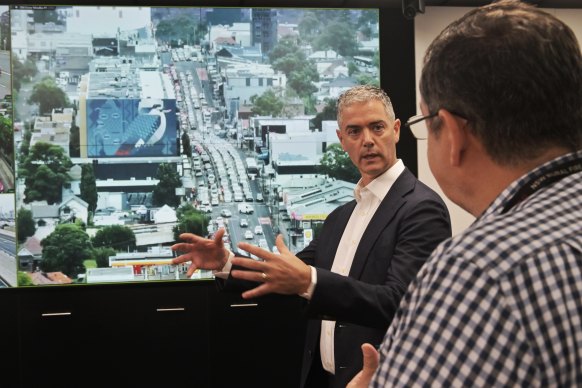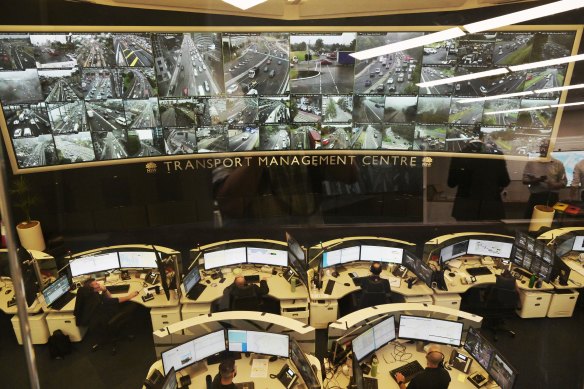Motorists are being held back at traffic lights on Victoria Road in Drummoyne to avoid creating major traffic jams on the Anzac Bridge and congestion rippling across the road network in Sydney’s inner west, transport officials say.
Almost three months after the Rozelle Interchange’s opening led to severe congestion, the state government is releasing travel time data for key arterial roads so commuters can plan trips and, where they can, avoid a “tradie peak” at 7am, followed by the main peak at about 8.15am.

Roads Minister John Graham in the transport management centre early on Thursday morning. A screen in the background shows Victoria Road in Drummoyne.Credit: Nick Moir
Motorists have complained that phasing of traffic lights along Victoria Road is leading to CBD-bound vehicles banking up to the Gladesville Bridge from the Iron Cove Bridge during the morning peak. Tuesdays, Wednesdays and Thursdays are typically the busiest days.
Inside the nerve centre for Sydney’s road network early on Thursday, transport officials explained the complex balance involved in pulling levers which can have a major bearing on motorists’ trips.
Transport Management Centre executive Craig Moran said traffic lights were phased along Victoria Road to avoid a bigger problem of the Anzac Bridge becoming gridlocked.
“It’s like pouring water into a funnel. There’s only so much you can get out the other end. The more you tip in, the more congested, and it flows out,” he said. “If we get to a point where we jam Anzac Bridge … then it just immediately goes back through the whole network.”

A conga line of vehicles on Victoria Road in Drummoyne during the morning peak on Tuesday last week.Credit: Nick Moir
The opening of the $3.9 billon interchange, which feeds lanes from the M4 and M8 motorways onto surface roads, has put more pressure on the Anzac Bridge, which acts as bottleneck as 10 city-bound lanes merge into four. The bridge can handle about 6200 vehicles an hour.
Before traffic light phasing was enacted in Drummoyne, Moran said sections of Victoria Road in Rozelle had become jammed, leaving vehicles from side streets nowhere to go. “You just get this cascading problem, and cascading delay, and that’s what we are trying to avoid,” he said.
Moran said it had not been unusual for traffic queues to extend back along Victoria Road and onto the Gladesville Bridge before the interchange opened.
Transport officials are using drones to give them a better overview of Victoria Road’s performance in real time, allowing them to make any necessary tweaks.

Controllers at the transport management centre at Eveleigh in inner Sydney on Thursday.Credit: Nick Moir
Travel times for CBD-bound traffic on Victoria Road from Gladesville Bridge to Anzac Bridge were about an hour during the morning peak in the days immediately after the spaghetti junction opened in November. Last week, the trip averaged 30 minutes.
Travel-time data for motorists and bus passengers using key sections of Victoria Road and the City West Link will be published weekly on Fridays for the next three months.
Roads Minister John Graham said the release of the data was a practical way to help people plan morning trips.
“While many motorists from western Sydney are benefiting from large reductions in travel time since the opening of the Rozelle Interchange, the inner west community has been adversely affected – that is the reality,” he said.
Apart from traffic light phasing, ramp meters are the other main lever that road officials rely on to control the rate of vehicles passing onto another section of roadway.
Ramp meters – traffic lights that allow one or two vehicles to pass at a time – were installed on Victoria Road and the City West Link late last year for CBD-bound motorists approaching the Anzac Bridge.
A third ramp meter located where the toll-free Iron Cove Link tunnel merges with the WestConnex motorways in the interchange will become operational in coming weeks. The Iron Cove Link has about 1400 vehicles pass through it every hour during the morning peak.
Transport for NSW acting executive director Chris Zito said the ramp meter was installed to improve traffic merging between the Iron Cove Link and the M4.
“If we can get that merge working more consistently, without those shock waves of big clumps of traffic coming together, that will help all of this work better,” he said.